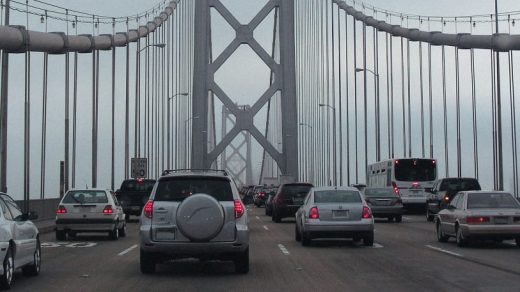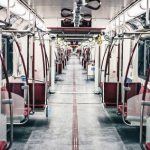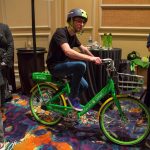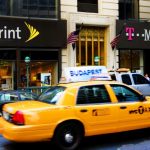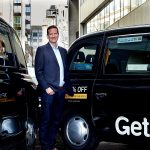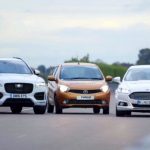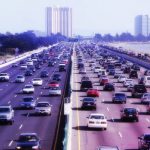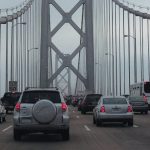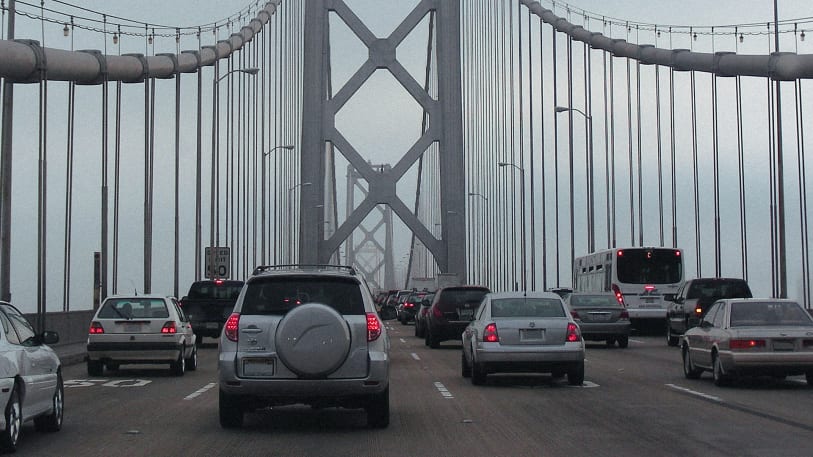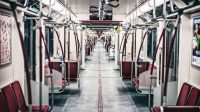A Solution For The Bay Area’s Traffic Woes, And Other World-Changing Transportation Ideas
For all its capacity for innovation and genius, Silicon Valley has yet to solve its traffic quandary. Throughout the Bay Area, roads have become a gridlocked hell; what should be a 20-minute drive up from San Jose to Mountain View, or across the Bay Bridge from Oakland into San Francisco, could very well take over two hours. One commuter, describing her trip through the region, told The Mercury News: “I really did shed a few tears.”
She’s not alone: According to a recent Bay Area-wide poll, two-thirds of the region’s residents are demanding a major investment to fix the problem, even that means higher taxes. Joint Venture Silicon Valley (JVSV), a nonprofit dedicated to identifying and solving the region’s issues, has been grappling with the traffic dilemma for years, and it’s now landed on a fairly radical but very comprehensive solution.
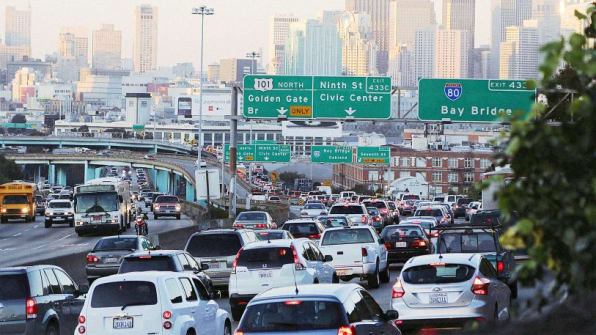
Called Fair Value Commuting (FVC), the five-part proposal combines technology and policy and will, once rolled out over the next 24 months, eventually reduce the share of Bay Area commutes made by single-occupancy vehicles (SOV) from around 75% to 50% (around 1 million trips). To do so, it’ll have to get local transportation providers, companies like Google and Facebook, and politicians on board, but Steve Raney, JVSV’s executive director for smart mobility, tells Fast Company that there’s already enough interest in the region–and more than enough desperation–that the plan is likely to take root and scale up. FVC was the winner of the transportation category of Fast Company’s World Changing Ideas Awards. (You can see short descriptions of all the finalists below.)
To implement the strategy, JVSV has authored a bill that could be introduced by local city councils with a simple-majority vote. The bill would enact a city-wide “trip cap” to limit the number of car trips through the region; companies within the city would be permitted a certain number of commuter vehicles depending on their size, and companies that exceed that number would have to adopt the commute-reducing strategies outlined in the FVC plan.
Local ordinances have a proven record of cutting down SOV commuting in the area: After Santa Clara County, home of Stanford University, introduced a trip cap in 2000, Stanford responded by slapping a parking fee of $ 4 per day on SOV commuters, and transferring that revenue toward public transit and carpool benefits for other employees. The Stanford scheme reduced SOV commuting by 25%–the same goal that JVSV hopes to achieve for the whole region—and saved the university $ 107 million in parking structures it would have had to build to accommodate its growth and employees’ commuting habits.
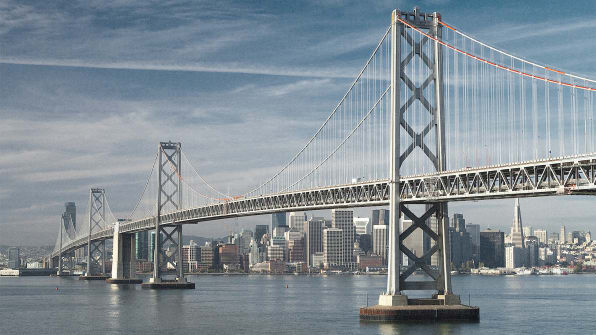
Significantly, none of the revenue created by Stanford’s plan went back to the government; it all remained among university employees. California’s Proposition 26 requires that proposed state and local fees related to curbing driving or hitting climate goals (such as a gas tax) have to pass with a two-thirds majority. But laws that set those objectives without new fees attached can pass with a simple majority vote. This, Raney says, is evidence of the oil lobby’s influence, even in climate-friendly California, but proposals like Stanford’s and JVSV’s skirt this roadblock by supporting company mandates that collect and distribute revenue among drivers, instead of funneling it back into government.
The way Fair Value Commuting works, Raney says, is by encouraging companies to increase the penalty on SOV commuting for employees, while offering a streamlined alternative. To clear up the roads, “you have to increase the price of driving in some way, because humans react well to sticks, and not so much to incentives,” he says. “But there’s also the fact that nobody wants to be inconvenienced.”
For the penalty aspect of the plan, FVC, like Stanford, would require companies to charge a fee of $ 3 per day to SOV commuter employees. That money would then be collected and put toward providing alternative-commute benefits to other employees (it’s the classic Robin Hood model, but for drivers). The “revenue-neutral” structure would give companies a way to incentivize non-SOV commuting without digging into their own pockets.
But how could employers determine who gets fined, and who gets the rebate? Raney says that while trip-tracking software is still being finessed, companies will be able to make use of data that comes from employees’ phone to detect how each person commuted. That “Enterprise Commute Trip Reduction” software would aggregate employee data into a dashboard, and automate commuter benefit programs. JVSV is working with transportation data management companies like Luum and RideAmigos to develop this technology.
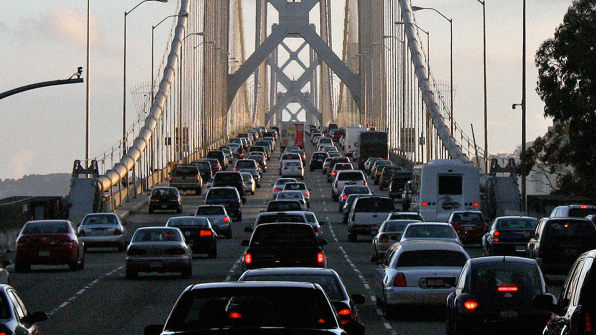
The third component of FVC is a mobility aggregation app, which will knit together services like Lyft, Zipcar, and local public transit options like Caltrans, coordinating scheduling and payment in one place. Alongside that, JVSV will identify ways to improve gap-filling options for the first and last mile of people’s commutes–electric scooters and improved bike-share networks are options, Raney says. The last component of the strategy will entail working closely with the Bay Area’s existing transit networks to integrate them into the plan–given that there are 24 separate transit agencies in the region, some streamlining is definitely in order.
With cities across the U.S. becoming more and more congested (the proliferation of ride-sharing services like Uber is contributing to the problem), it’s clear that a one-note, brute-force approach to mitigation won’t work: Fixing this issue will require flexibility, collaboration, and scalability, all of which, Raney says, FVC provides. And the Bay Area, he adds, is the perfect testing ground. “The regional and public policy in Silicon Valley and California is a big change agent,” he says. “It could end up being the biggest thing changing transportation in the next 10 years.”
Here’s more about the finalists in the transportation category:
Project Interzone
Project Interzone
It’s a foregone conclusion that–all of our best ride-sharing and public-transit developments aside–cities will continue to get more crowded. Instead of relying on standard traffic-mitigation strategies, Project Interzone suggests abandoning our traditional concept of linear time. It sounds like something out of a science fiction novel, and the organizers, in fact, came up with the concept through developing a fictional scenario: A New York City divided–by an entity called the Department of Tim– into three time zones, each three hours apart. Project Interzone imagines gridlock relieved via a schedule spread out enough to disperse traffic flows, but not so extreme as to completely disrupt residents’ lives and relationships.
Civil Maps
Civil Maps
Beyond a standard GPS, self-driving cars will need a practically human level of sensitivity to navigate successfully through unfamiliar terrain. Civil Maps’ “location and augmented reality (AR) maps” translate the surrounding scene into 3D, data-driven maps that are updated in real time. Through crowdsourcing, the Civil Maps team will build out a centralized map collection that will apply to any to any environment at a low cost.
Smart City Challenge
Vulcan
Cities are major drivers of climate change, but also where the solutions are likely to originate. With his team at Vulcan, founder and philanthropist Paul G. Allen created an incentive for cities to realize a more sustainable an efficient approach to urban transit: a $ 40 million prize to the winning city to re-imagine its transportation system. Launched in December 2015, the Smart City Challenge aimed to motivate cities to use data, technology and creative thinking to become more sustainable. Seventy-eight cities across the country submitted ideas, which ranged from electric freight trucks in Kansas City to a network of shared self-driving cars in San Francisco. The scope of proposals submitted to the Smart City Challenge represents the direction in which all cities need to head to curb climate change.
Otto
Otto
For decades America romanticized the life of a trucker: the open road, the freedom, the solitude. But conditions on the road have worsened, and driving has become increasingly unsafe for the people behind the wheel. Otto is developing self-driving kits that can be applied to any freight truck, improving the safety and productivity of drivers who often work exhausting hours to boost their earnings. Self-driving trucks remain alert, even when drivers are not fully, and by maintaining consistent speed and pooling shipments to carry a full cargo, Otto (which is currently being sued by Google parent company Alphabet for major theft of intellectual property) also aims to reduce the environmental footprint of long-haul transit.
AeroLiner3000
Andreas Volger Studio
Despite being known for its double-decker buses, the U.K. has shied away from double-decker trains. Though they’d increase transit capacity, engineers have worried that they won’t fit underneath the island’s bridges and tunnels, which were built much lower than those on the European continent. By taking a leaf from the aerospace industry, Andreas Volger Studio has developed a streamlined double-decker train that, like an airplane, forgoes comfortable standing room for the sake of design. On the lightweight train, as many as 700 passengers (a 30% increase over current trains) can sit comfortably, and increasing efficiency across the rail system will also cut carbon emissions.
On-the-Go H2O
Ford Motor Co.
With clean water in short supply in many parts of the world, and one in 10 people struggling to access it, developing alternative ways to source it is crucial. Ford’s contribution: A reservoir attached to a car’s air-conditioner ventilator, which collects condensation that would otherwise drip onto the pavement. In an hour, one On-The-Go H20 system could collect 24 ounces of water—enough to fill four water bottles. In many developing countries, where there’s a scarcity of water and a fair number of cars and trucks, the device could deliver water to people in need.
Connecting Cities and Citizens
Mastercard
Commuting by public transit suddenly becomes a lot easier when you don’t have to wait in line to buy a ticket. Mastercard is working to help cities set up electronic payments for their transit systems. In 2016, commuters on New York’s Long Island Railroad and Metro-North trains gained access to MTAeTix–cashless tickets powered by Mastercard and Apple Pay. Since the system launched in August, over 280,000 new accounts were created; Mastercard will work with other cities to demonstrate how private and public sector can work together to boost transit ridership.
Hyperloop One
Hyperloop One
Hyperloop One is the transportation version of the internet–fast, connected, and disobedient of the barriers of space and time. Using a custom electric motor, Hyperloop One moves levitated pods through a network of tubes at speeds up to 700 miles per hour with no emissions. A trip between Sydney and Melbourne, which would ordinarily take five hours and struggling through two airports, would be condensed to 55 minutes. Teams at three campuses in Los Angeles and Nevada are currently demonstrating the system and planning the development of a 500-kilometer network linking Helsinki and Stockholm in 28 minutes.
Cobi
Cobi
Generally speaking, using your smartphone while cycling entails taking your life into your hands. But Cobi, a smartphone-powered bike system, does everything for you, from navigating to changing music to making calls, while you hold onto the handlebars. The smartphone attaches to a dock (which also functions as a charger) installed at the front of the bike; because it’s Bluetooth-enabled, the system responds to voice commands. The point of Cobi, according to the designers, is to making your bike as advanced and responsive as a car.
Supersonic airline
Boom
Traveling faster than the speed of sound, Boom Technology’s supersonic airline would cut travel between New York and London to three hours, San Francisco and Tokyo to five. The company is developing a fleet of supersonic aircraft, and Virgin has announced that they’ll buy the first 10 airplanes produced. By the next decade, Boom envisions a network of 500 routes; founder Blake Scholl’s goal is “to enable anyone to fly anywhere in the world in under five hours, for $ 100.”
RideCell
RideCell
Imagine if you could get across the city by hopping in a rideshare, switching to public transit, then using car-share to cross the last mile to work. If those systems aren’t integrated, that trip would be a logistical nightmare. By using RideCell–an adaptable, scalable transit aggregation platform–transit agencies, companies, universities, and car companies can develop an app that integrates all available transit options in a single place. RideCell offers consumers a streamlined way to avail of a variety of transit modes; for transit providers, it keeps people engaged with their services through making it much easier to integrate them into their commutes.
Parkarr
Parkarr
Anyone who has driven in a city knows the pain of circling, seemingly endlessly, in search of parking. Parkarr, a crowdsourced app that connects drivers looking for parking with those leaving those spots, wants to make that frustration a thing of the past. Anywhere from real-time to four days in advance, drivers can enter a location where they need parking; through the app, they receive an alert when a “host” (a driver leaving a spot) accepts their request. A GPS tracking system informs the host when the driver is close so the handoff can go smoothly.
The Smiling Car
Semcon
Before crossing the street, 80% of pedestrians will make eye contact with the driver at the intersection to make sure they’ve been seen. That very human interaction is impossible with a self-driving car, so the Swedish technology company Semcon invented The Smiling Car, which lights up with a smile to show it’s sensed a pedestrian, and will wait for them to cross.
The Green Engine
United Technologies
By developing a more efficient engine to power airplanes, United Technologies is ushering in a greener way to travel. Its engine, which took 20 years and $ 10 billion to develop, reduces fuel consumption by 16%, cuts particulate emissions by 50%, and reduces the aircraft noise by 75%. Reducing fuel consumption also cuts carbon dioxide emissions: Currently, commercial aviation emits 705 million metric tons of CO2 each year (2% of global carbon emissions). United Technologies’ engine would reduce emissions by 3,600 metric tons per aircraft each year.
BQXL: Brooklyn-Queens Crossline
Gensler
Public transportation in New York City was originally built with Manhattan as the focal point. But now that Brooklyn and Queens are rapidly developing as residential and business hubs, the lack of connectivity between the two boroughs is obvious. The design and architecture firm Gensler has proposed a 15-mile, high-powered rail line between the Brooklyn Army Terminal and Jackson Heights, Queens, that would link previously disconnected neighborhoods, spur development, and do by using existing freight lines, currently used at night to deliver waste to landfills. Gensler sees the BQX reworking existing infrastructure to support equitable development and create more accessible communities for people in the outer boroughs.
The Proterra Catalyst E2 Series
Proterra
Proterra saw that today’s electric buses can only handle about 45% of their daily mileage through cities without having to recharge, and decided that wasn’t good enough for our booming transit needs. The manufacturing company developed a battery that lasts for up to 350 miles while emitting zero tailpipe emissions. Each time a diesel vehicle is replaced by a zero-emission bus, CO2 emissions drop 243,980 pounds over the course of a year; the Catalyst E2 delivers a sustainable transit option without the inconvenience of having to stop mid-route to charge.
(56)

